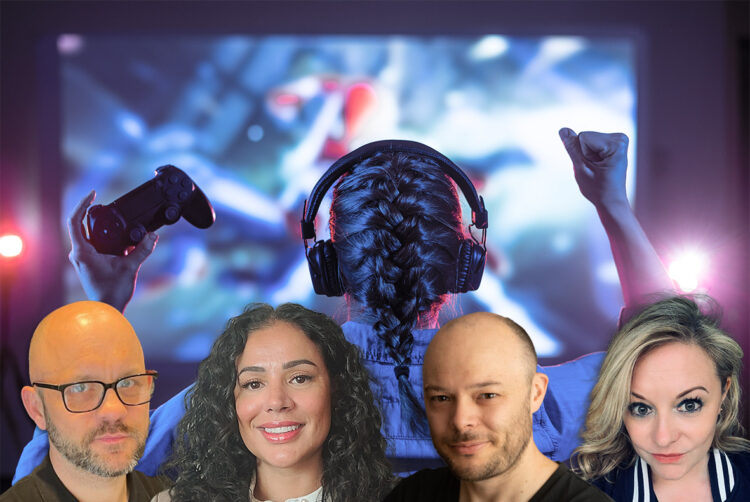What’s 1 thing that would get brands to spend more on gaming?

Advertising options in gaming have developed significantly over the past few years, but many brands are still fearful to dip their toe in the water.
Often, this comes down to a lack of education or uncertainty around return on investment for especially larger, upper-funnel activations inside game worlds.
Ahead of The Future of Audio and Entertainment conference this month, The Media Leader asked gaming experts what would get brands to spend more on gaming.
Phil Rowley, head of futures, Omnicom Media Group
 “The thing I would like to emphasise to brands unfamiliar or intimidated by gaming is, first, don’t get gaming and the metaverse mixed up.
“The thing I would like to emphasise to brands unfamiliar or intimidated by gaming is, first, don’t get gaming and the metaverse mixed up.
“Gaming is computerised competition in all forms, from Call of Duty on a console to Scrabble on a mobile device. At its broadest definition, there are 3bn gamers globally. The immersive 3D worlds of virtual reality are a small subset of that. Don’t mistake the tree for the forest; this is a massive opportunity.
“Second, brands should view gaming as a spectrum of opportunities, with a host of easy and affordable entry points that use familiar metrics from traditional media. A useful analogy is sport: you can advertise on the shirts of a team or the perimeter boards at the match. Or you can also sponsor the broadcast or buy a 30-second ad in the half-time break.
“Gaming is exactly the same: there is a plethora of advertising formats for any budget, including videos, banners, audio and outdoor ads, along with options for sponsorship and partnerships. These are as straightforward as those found in non-gaming media channels.”
Nina Mackie, co-founder and chief revenue officer, WeGame2
 “Boosting adspend in gaming involves several strategies, but a key focus should be on creating a unified purchasing process. The gaming industry’s fragmentation is a significant barrier, as noted by brands and agencies, making dealings with numerous vendors and their varied products and metrics both time-consuming and inefficient.
“Boosting adspend in gaming involves several strategies, but a key focus should be on creating a unified purchasing process. The gaming industry’s fragmentation is a significant barrier, as noted by brands and agencies, making dealings with numerous vendors and their varied products and metrics both time-consuming and inefficient.
“In response, the IAB refined their intrinsic in-game guidelines in August 2022, standardising viewable impression metrics and expanding beyond 2D formats. Despite these efforts, the advertising landscape in gaming remains largely disorganised.
“The introduction of platforms like IION, offering a singular solution to buy ad space targeting gamers ‘in the game’, ‘away from the game’ and ‘around the game’, signals a shift towards simplification. This approach, akin to advertising on social media or connected TV (CTV), promises to streamline reaching gaming audiences, potentially setting a precedent for others to follow.”
Michael Smith, vice-president, sales, EMEA, Anzu
 “One thing that will get brands to spend on gaming is more education backed by data. Most brands know gaming is a leaned-in medium that generates unprecedented attention. Still, there are many misconceptions about how easy it is to get into gaming and what tangible impact it can have on your campaign.
“One thing that will get brands to spend on gaming is more education backed by data. Most brands know gaming is a leaned-in medium that generates unprecedented attention. Still, there are many misconceptions about how easy it is to get into gaming and what tangible impact it can have on your campaign.
“For example, Anzu just published a study that dispels the myth that in-game is only good at driving upper-funnel awareness. The data showed that these ads work across the entire funnel, including boosting purchase consideration (+5 points) compared to online media benchmarks, outperforming display, online video and CTV formats.
“As more brands continue to look to gaming, more education and data will inevitably come. Still, I can’t stress how important it is that we work together as an industry to help this space grow and mature, which in turn will bring more standardisation, best practices and confidence to the space.”
Lucy Rissik, video games and brand partnerships consultant
 “First, I think that many brands underestimate the industry, not realising the size and scope. One thing that is often overlooked is that roughly 50% of gamers are women — actually more women over 18 play games than boys under 18. By really understanding the opportunity and industry, brands can actually benefit from a highly engaged and dedicated audience.
“First, I think that many brands underestimate the industry, not realising the size and scope. One thing that is often overlooked is that roughly 50% of gamers are women — actually more women over 18 play games than boys under 18. By really understanding the opportunity and industry, brands can actually benefit from a highly engaged and dedicated audience.
“On the flip side, the games companies should be more open to opportunities that come their way. Having brands that are culturally relevant in a game will actually enhance the experience and mean that gamers see how much the games companies understand them (and what they like). I would also love to see more creative ways of integrating brands into games and going beyond a free skin or a billboard.”
This will be one of the major themes, alongside other hot topics affecting brands and agencies, at The Future of Audio and Entertainment, taking place in London on 18 April.



